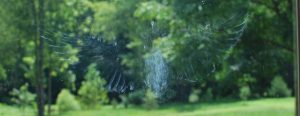
In the fall of 2014, biology Professor Dr. Kathy Winnett-Murray and five former Hope students had the unenviable task of seeking out and documenting bird carcasses found beneath the windows of six campus buildings.
While the quest to find deceased birds may seem morbid to some, the purpose of their investigation was anything but macabre for Winnett-Murray, whose research focuses on the responses of animals — most often birds — to environmental changes brought about by human alteration of habitats.
Winnett-Murray’s research team, which included Michael Barrows ’15, Nicholas Gibson ’17, Emily Kindervater ’15, Courtney Lohman ’16, and Alexandria Vandervest ’15, wanted to learn if certain buildings, and their locations, were more apt to be deadly to birds than others. They hope their study will eventually save birds when combined with the same research methods conducted simultaneously at other colleges. Together with 39 other research teams across North America, the peripheries of 281 various-sized buildings situated in varying urbanized settings were scrutinized using a standardized search protocol.
At Hope, students paired up daily for four weeks to search the perimeters of Durfee Hall, the Schaap Science Center, Bekkering Admissions House, Gilmore Hall, Oggel Cottage, and the Beardslee Library building on the campus of Western Theological Seminary. Each structure was chosen for its size and landscape variety.
The team’s research was published in the fall 2017 journal, Biological Conservation, and is included in the article, A Continent-Wide Analysis of How Urbanization Affects Bird-Window Collision Mortality in North America. The paper, which lists Hope as a study site and Winnett-Murray as co-author, documents bird-window collisions from Whitehorse, Canada, to Mexico City, Mexico — and 22 United States in between.
Each of the study’s participants, including Hope, is a member of the Ecological Research as Education Network (EREN), a collaborative consortium that “addresses questions that need a vast geographic range in order to provide answers that we (Hope) can’t provide on our own very easily,” says Winnett-Murray.
“I got involved with the project out of concern for a lot of ways that people have changed the environment that both benefit wildlife or harm wildlife,” she said. “We don’t really understand the subtleties very well at all.”

Not surprisingly, the study confirmed that bigger buildings kill more birds. That’s the direct effect of larger surface areas. But what surprised the study’s authors was a finding that could have only emerged by comparing multiple sites.
Over the course of their month-long research, the group found just 12 dead birds. That’s good news if you’re a bird, but it was sometimes monotonous for the research team. “We went a lot of days without finding anything so I was a little bit concerned that we weren’t going to be able to provide much information for the study. Turns out some sites found zero bird carcasses,” Winnett-Murray said.
“We were thorough,” Winnett-Murray remembers. “First, Greg Maybury (director of operations at Hope) provided us with each building’s footprint measurement. From there, we had to measure the window surface areas on each of the six buildings. That was a lot of work. You would be very surprised by all of the different window sizes on individual buildings. We photographed each outside building wall, determined how many windows of each size there were, and then we used image analysis on the digital photos to determine how much total glass was on the outside of each building.
“Finally, we walked, really slowly around each building, doubling over each other’s steps, and scoured under ivy, through plantings, in window grates,” she recalls.
The bird crew also worked closely with Hope’s physical plant staff in another way. “We informed their staff about our project to explicitly ask them NOT to remove any bird carcasses from around buildings while our study was in progress.”
Not surprisingly, the study confirmed bigger buildings kill more birds. That’s the direct effect of larger surface areas. But what surprised the study’s authors was a finding that could have only emerged by comparing multiple sites: Birds were disproportionately dying from window collisions when large buildings were situated in a rural landscape, as opposed to urban ones.
“The buildings with lots of greenspace and landscaping around them, and fewer other buildings around, were absolutely deadly,” Winnett-Murray says.
“We’re inadvertently drawing birds into a dangerous place with a lot of glass that they’re going to smack into and die,” she contends.
One reason for this, she surmises, supports the beacon hypothesis: Birds are attracted to appealing areas where they can find food and rest. And sometimes those areas are right next to buildings’ windows. “We’re inadvertently drawing birds into a dangerous place with a lot of glass that they’re going to smack into and die,” she contends.
The irony is that the more wildlife-friendly the habitat next to a building, the more birds are potentially killed. So what can be changed to prevent this unintended consequence?
Winnett-Murray suggests new construction or renovated building projects can use LEED-certified windows that reflect light to reduce bird-window collisions. Landscape architects can put more distance between landscaping and building windows, and homeowners should not put bird feeders right next to windows.
“I think that most people are aware that once in a while birds smack into glass,” says Winnett-Murray. “But I think people are very unaware how some places are hurting birds more than others. I hope this paper — which has already gotten a lot of traction — helps get the word out to the public so we all can make a difference to help save birds.”


Thank you, Kathy and students. My wife, Julie, was the editor of Birder’s World leading to caring more carefully and enriching our days as well. Your work means very much to us.
And of course, Eva, your uncommon writing ability both informed and made us feel that we were there, right there.
My thanks and appreciation to all.
Jack and for Julie
Special thanks to the former students who did the hard part!